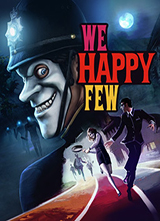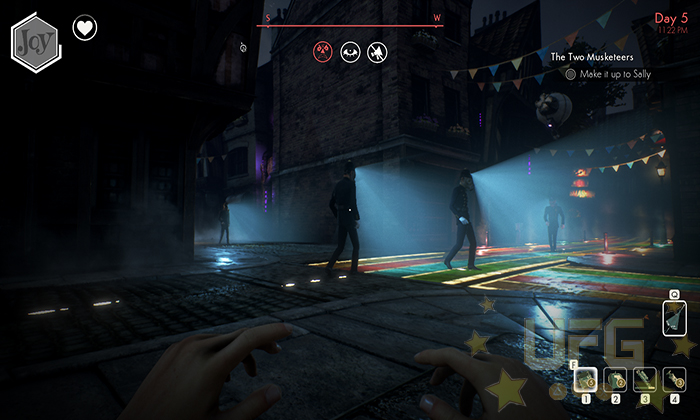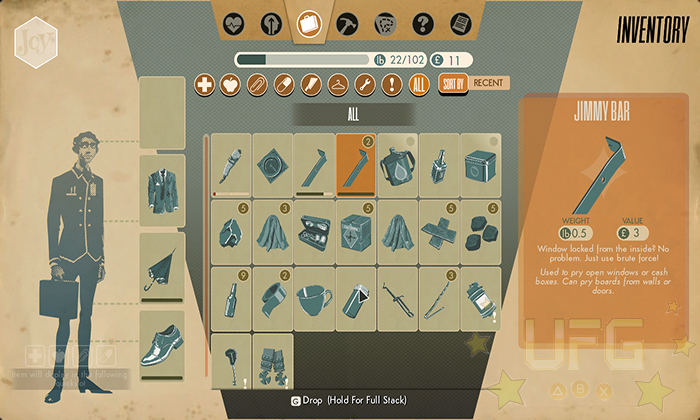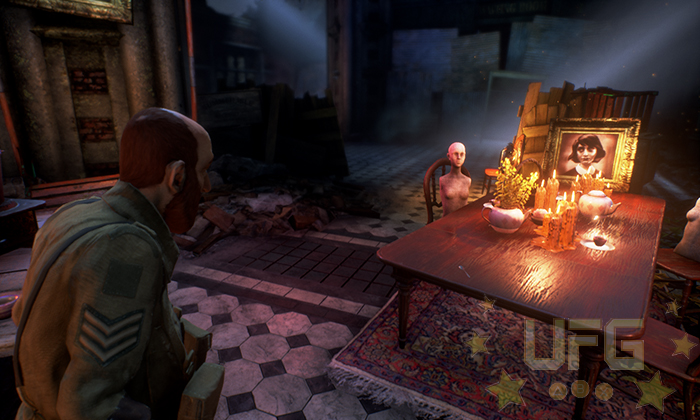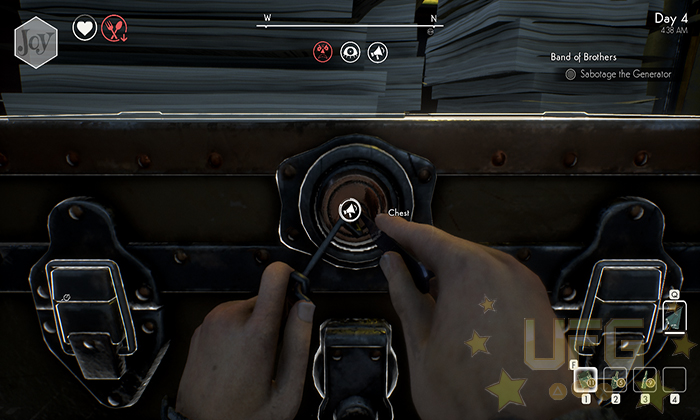We Happy Few
We Happy Few takes place in an alternate past – one where Germany captured Great Britain during WWII – on an island town called Wellington Wells. To rid their town of its oppressors, Wells’ citizens agreed to do something terrible. So much so, that their government decided to develop a drug called Joy to suppress everyone’s memories. Fast forward years later and this retro-futuristic town has become a dystopia; an island held captive by an oppressive governing body and the remnants of its past actions. The town’s inhabitants are forced into a state of complacency thanks to the Joy. Forgoing an obnoxiously cheerful disposition results in suspicion, as those found joyless are deemed downers and are typically forced fed the drug, ran out of town, or murdered.
If I had to describe We Happy Few’s premise, I’d say it was a mash-up of The Stepford Wives (the 1980’s made-for-tv version) and A Clockwork Orange. People are being drugged out of their minds, hallucinating flowers and rainbows, in hopes of hiding from reality. Going so far as to wear face coverings that are reminiscent of the comedy theatrical mask. However pleasant they pretend to be, they’ll quickly become violent at the mere sight of someone deemed unpleasant. This is where our first protagonist, Arthur Hastings comes in. After coming off his Joy induced high, he was considered a downer and promptly ran out of town. He ends up in one of the outer districts amongst other homeless people…
Players will take control of three different characters over the span of the game, each one trying to escape the island. Arthur, being the first playable character, acts as an introduction to the game’s world. Here we learn that We Happy Few is one-part action adventure and one-part survival game. The player will need to complete missions as Arthur slowly works his way through his part of the campaign. In between missions, he’s required to drink, eat and sleep like a normal human. This was a bit of an issue in the game’s Early Access build; these nagging physical requirements would constantly pull players away from the story at the most inconvenient times. Thankfully, Compulsion toned these mechanics down some. Not sleeping or eating, for instance, no longer results in death. Instead, they’ll lower the amount of stamina Arthur has, making it harder to fight off and/or flee from Wellington’s crazed citizens.
Other survival mechanics come into play over time. Crafting a suitable weapon is just as important as acquiring medicinal items to deal with an illness or wound. The thing that makes these mechanics interesting is We Happy Few’s narrative spin. In order to blend in with the people inhabiting the immediate area, one would have to craft the proper attire. In the case of the outer districts, a torn and ragged suit was most appropriate; the people there didn’t like “fancy” city folks reminding them that they were poor. The opposite holds true when visiting the more affluent parts of the island. Then there is Joy. Most of the story takes place in the heart of Wellington Wells. Acting different (running, jumping, fighting, doing anything annoying) would attract the wrong kind of attention. And once people notice Arthur’s off his Joy, he’ll have to run for his life. Or, pop a Joy.
The problem with using Joy is two-fold. While it does allow the player to pass as a normal citizen, taking too much will cause Arthur to lose his memory again (plunging all of his stats). The other issue comes from abstaining. As soon as the drug wears off, Arthur will temporally suffer from withdrawal. Not only will he draw ire from anyone he encounters while in this state, he’ll also be slightly weaker. It’s a tough spot to be in. If that wasn’t bad enough, there are special gates/machines that seek out downers, making the choice to not take Joy that much harder. Imagine needing to get through a rough part of town. You take some Joy to pass through a few check points, slide by some Bobbies (police). Only then do you realize that the person you need to visit in order to complete a quest is still far off. With your Joy levels steadily declining, do you risk making a run for it or keep walking in hopes of no one noticing the early effects of withdrawal? Either way, you’re sure to get creepy stares from those around you.
Sally Boyle and Ollie Starkey, the other protagonists, have their own issues to content with. Because of this, the game changes to better reflect their struggles. Take Ollie, the army vet/recluse. He must eat and sleep just like the other two characters. He also needs to balance his blood sugar. If it gets too high, he’ll start to lose health. If it gets to low, he’ll start randomly yelling at NPCs. Slowly dying is never a good thing. But having to worry about offending people who become violent when someone doesn’t look happy, spells doom for someone looking to keep a low profile. Crafting the proper medication (or in some cases, eating the right foods) will help in keeping Ollie balanced. Of course, things won’t always go as planned. With Arthur, he had the luxury of running away or hiding. Ollie can’t run for long distances and isn’t very great at stealth. He can throw a mean punch though; with this character, We Happy Few goes from being mostly a stealth based game to one where brawls happen on a regular basis.
The survival-based gameplay is great at first. Safely traversing We Happy Few’s open world was challenging. Using stealth – sneaking around, hiding in trash cans, choking out enemies, etc. – I was able to circumvent most obstacles in my path. Along the way, I made sure to collect every piece of junk I could find for crafting purposes. This strategy paid off. It wasn’t long before the game forced me to utilize my tools. A lockpick to open a door. A crafted drug that mimicked Joy (with none of the side of effects). A portable record player used to distract guards. I ended up using most of my collected items while completing each mission. To further bolster my efforts, I also unlocked a series of perks. Points are rewarded after finishing a quest line, which in turn, are used to upgrade each character. Stronger attacks, health improvements, quieter movements, better stamina. All of these things became useful at the right moments by either presenting a way out of trouble or offering a means of protecting myself.
Being able to overcome the oppressive circumstances felt good. Things started to change about mid-way through Arthur’s arc though. This is because most of We Happy Few’s missions are nothing more than tedious fetch quests, each one more convoluted than the last. They’d often send you from point A to B to C, only to make you trek all the way back to A (with an item) before reaching D. At one-point Arthur exclaimed how he’d wasted his time helping someone for little to no gain – a sentiment I rightfully shared. Worse still was how these fetch quests tried to reinforce the survival angle. It’s one thing to make the going tough, allowing the player to rethink his or her approach to a problem. It’s another to lock a quest item behind a door that can only be opened by a lockpick. No keycard. No gullible NPC. Just a lockpick. And because I had used all my bobby pins in search of potential loot, I didn’t have one during this key part of the campaign. Which meant, I had to scour the surrounding neighborhood in hopes of finding one in the trash, in a cabinet, or someone’s dresser drawer. My progress came to an abrupt stop.
Fast traveling doesn’t help to negate all of the walking you’ll have to do to complete these quests. Back and forth between districts. It became rather tiresome. The same goes for Sally and Ollie’s arcs; they’re only available to play in succession once Arthur’s arc is completed. It was more of the same, just slightly tweaked to suit the strengths and weakness of each character. Add in a few annoying bugs, like dropped dialogue or faulty missions that need to be replayed due to NPCs getting stuck in the environment, and you can see why I grew weary hours in.
It seemed like Compulsion just wanted to pad the experience. That or they couldn’t come up with enough interesting things for the player to indulge in. Whatever the case, they were able to somewhat save We Happy Few by crafting a decent story. Figuring out what happened to these three characters through recovered notes, dialogue, and flashbacks is worth suffering through the later parts of the game. The twists and turns were compelling as well. Because the bulk of the story is centered on Arthur, he’ll eventually run into Sally and Ollie. These moments play out differently based on each person’s perspective. The theme here is our memory, which reinforces the game’s overall narrative. Sometimes, we only remember what we want to remember…
With its great premise, impeccable writing, focused (at times) gameplay, and wild sense of style – this amalgamation of genres/ideas should’ve been on a fast track to some sort of end-of-the-year award. Or at the very least, a game with themes worth discussing long after it’s been uninstalled. Unfortunately, We Happy Few doesn’t quite reach the lofty heights set by Compulsion.
Honorable Mention: We Happy Few is one of the few (heh) games where the leveling system actually complements the gameplay. Instead of offering abilities that one would expect a protagonist to have at the start of their journey based on the narrative – like a decent stamina bar, the ability to craft, proper aiming mechanics, etc. – We Happy Few provides perks that reinforces whatever role you’re trying to play. Arthur is already a great stealth-based character, so the perks in that category are only there to make him even better; he isn’t a shell of a character, being upgraded just to rise to a basic level of competency. Every ability, regardless of your playstyle, is useful. That is a rare feat.
Gameplay:
5
There is a lot to like here, especially concerning the well-crafted story. The tedious missions, constant backtracking and bugs nearly ruined the experience though.
Graphics:
7
I love the art style. The repeated elements (it’s possible to see five of the same NPC all huddled inches away from each other) and visual bugs plague the screen though.
Sound:
9
Both the voice acting and haunting musical score are great.
Replay Value:
4
I can understand wanting to replay each act to learn everything there is to know about these characters. An endless mode is also on the way. That said, I’m hesitant to revisit Wellington Wells.
Final Score:
6.3
